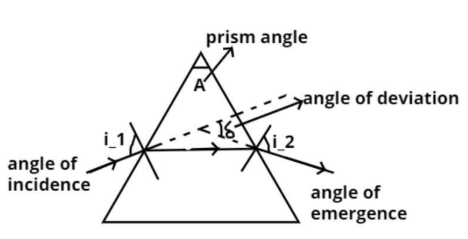
Define the following:
(A). Define prism angle and angle of deviation of a prism.
(B). Write the sequence of colors in the spectrum formed by the passage of white light through prism.
(C). Explain the process of formation of a rainbow.
Answer
586.2k+ views
Hint – In this question use the concept that a prism is generally made up of two refracting surfaces so the angle between these two refracting surfaces is called as prism angle, moreover when a ray of light passes through the prism it is eventually refracted twice first by the incident refracting surface and then by the second refracting surface this helps explaining the angle of deviation. Formation of rainbow can be seen artificially as well as naturally. Use this to approach the problem statement.
Complete step-by-step solution -

$\left( {\mathbf{a}} \right)$ Prism angle and angle of deviation
Prism angle: A prism is shown above with two refracting surface and the third surface is grounded as shown in the figure, the angle between the two refracting surface is called as prism angle, often denoted by A, in an equilateral triangle the angle is 60 degree and in a right angle triangle it is equal to 90 degree.
Angle of deviation: As we all know a ray of light is deflected twice in a prism so the angle of deviation is the sum of these two angles and the difference of the angle of prism, where first angle is angle of incidence and second angle is angle of emergence,
So angle of deviation = angle of incidence + angle of emergence – angle of prism
$ \Rightarrow \delta = {i_1} + {i_2} - A$
As shown in the figure.
$\left( {\mathbf{b}} \right)$ Sequence of colors in the spectrum formed
Whenever a white light is passed through a prism a spectrum of colors is formed whose sequence is given below,
VIBGYOR – Violet, indigo, blue, green, yellow, orange and red.
$\left( {\mathbf{c}} \right)$ Process of formation of a rainbow
Here we have taken into consideration the formation of an artificial rainbow which involves the use of a glass prism and a source of white light.
A glass prism is taken.
Sunlight or a torch of white light is used.
When the sunlight or white light falls on the prism it shows the seven colors which is an artificial rainbow.
We can see the colors on the prism.
So this is the required answer.
Note – A rainbow can be formed naturally as well due to nature, in that there are three basic principles involved that is reflection, refraction and dispersion of light. In reflection the light waves travel in the same medium and are reflected due to reflecting surfaces, in refraction the light waves travel from one medium to another medium where the refractive index of the mediums are different. The phenomena of dispersion refers to the principle of separation of the white light into its constituent radiations.
Complete step-by-step solution -

$\left( {\mathbf{a}} \right)$ Prism angle and angle of deviation
Prism angle: A prism is shown above with two refracting surface and the third surface is grounded as shown in the figure, the angle between the two refracting surface is called as prism angle, often denoted by A, in an equilateral triangle the angle is 60 degree and in a right angle triangle it is equal to 90 degree.
Angle of deviation: As we all know a ray of light is deflected twice in a prism so the angle of deviation is the sum of these two angles and the difference of the angle of prism, where first angle is angle of incidence and second angle is angle of emergence,
So angle of deviation = angle of incidence + angle of emergence – angle of prism
$ \Rightarrow \delta = {i_1} + {i_2} - A$
As shown in the figure.
$\left( {\mathbf{b}} \right)$ Sequence of colors in the spectrum formed
Whenever a white light is passed through a prism a spectrum of colors is formed whose sequence is given below,
VIBGYOR – Violet, indigo, blue, green, yellow, orange and red.
$\left( {\mathbf{c}} \right)$ Process of formation of a rainbow
Here we have taken into consideration the formation of an artificial rainbow which involves the use of a glass prism and a source of white light.
A glass prism is taken.
Sunlight or a torch of white light is used.
When the sunlight or white light falls on the prism it shows the seven colors which is an artificial rainbow.
We can see the colors on the prism.
So this is the required answer.
Note – A rainbow can be formed naturally as well due to nature, in that there are three basic principles involved that is reflection, refraction and dispersion of light. In reflection the light waves travel in the same medium and are reflected due to reflecting surfaces, in refraction the light waves travel from one medium to another medium where the refractive index of the mediums are different. The phenomena of dispersion refers to the principle of separation of the white light into its constituent radiations.
Recently Updated Pages
Master Class 12 Business Studies: Engaging Questions & Answers for Success

Master Class 12 Social Science: Engaging Questions & Answers for Success

Master Class 12 English: Engaging Questions & Answers for Success

Master Class 12 Chemistry: Engaging Questions & Answers for Success

Class 12 Question and Answer - Your Ultimate Solutions Guide

Master Class 12 Economics: Engaging Questions & Answers for Success

Trending doubts
What are the major means of transport Explain each class 12 social science CBSE

Which are the Top 10 Largest Countries of the World?

Draw a labelled sketch of the human eye class 12 physics CBSE

How much time does it take to bleed after eating p class 12 biology CBSE

Explain sex determination in humans with line diag class 12 biology CBSE

Differentiate between homogeneous and heterogeneous class 12 chemistry CBSE




